Ditapis dengan
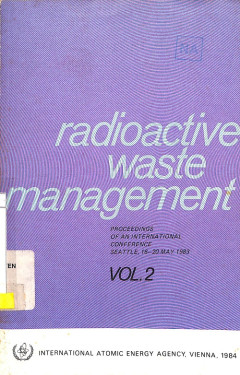
Radioactive Waste Management, Vol. 2: Proceedings of an International Confere…
Proceedings contains material Waste handling, treatment and conditioning at nuclear facilities (Session B.1); Handling, treatment and conditioning of waste from nuclear power plants (Session B.2); andling, Treatment and conditioning of waste from reprocessing plants: National experience (Session B.3); Handling, treatment and conditioning of high level and specific wastes from reprocessing plant…
- Edisi
- -
- ISBN/ISSN
- 9200203841
- Deskripsi Fisik
- 525 p. : Illus. ; 23 cm
- Judul Seri
- Proceedings Series
- No. Panggil
- 363.7289 PRO r v.2
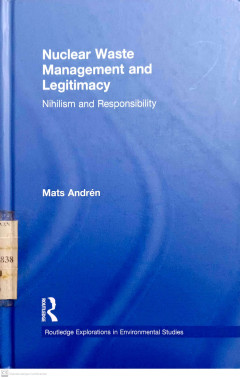
Nuclear Waste Management and Legitimacy: Nihilism and Responsibility
This text focuses on nuclear waste management, which can work in democratic countries only if viewed as legitimate by the population. The book posits the inability of democracies to establish such legitimacy as an explanation for the current absence of public policy decisions that can identify a solution.
- Edisi
- -
- ISBN/ISSN
- 9780415696920
- Deskripsi Fisik
- 110 p. : illus. ; 24 cm
- Judul Seri
- -
- No. Panggil
- 539.7 AND N
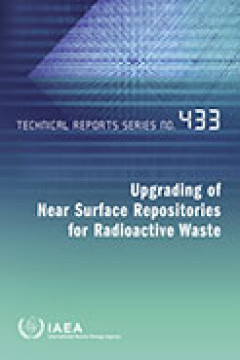
Upgrading of Near Surface Repositories for Radioactive Waste | Technical Repo…
This report considers a variety of circumstances that may require corrective actions to be assessed or implemented at near surface disposal facilities. The circumstances leading to the corrective actions, or the corrective actions themselves, may be of either a technical or a non-technical nature. Methodologies that can be employed to implement effective solutions to problems are discussed, inc…
- Edisi
- 433
- ISBN/ISSN
- 92-0-112704-9
- Deskripsi Fisik
- 137 p. : Illus. 24 cm
- Judul Seri
- Technical Reports Series No. 433
- No. Panggil
- 621.4838 IAE U
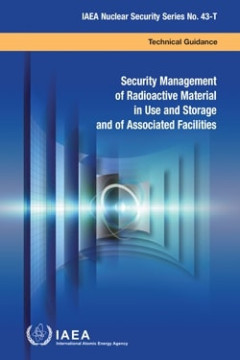
Security Management of Radioactive Material in Use and Storage and of Associa…
The IAEA Nuclear Security Series provides international consensus guidance on all aspects of nuclear security to support States as they work to fulfil their responsibility for nuclear security. The IAEA establishes and maintains this guidance as part of its central role in providing nuclear security related international support and coordination. The IAEA Nuclear Security Series was launched in…
- Edisi
- -
- ISBN/ISSN
- 978–92–0–118321–7
- Deskripsi Fisik
- 68 p
- Judul Seri
- IAEA nuclear security series
- No. Panggil
- 620.267:343.852 IAE s
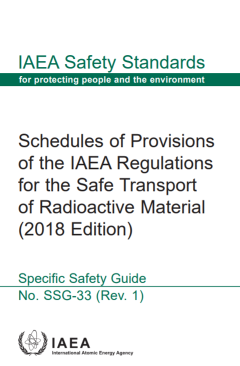
IAEA - Safety Standards Series No. GSR Part 5 : PREDISPOSAL MANAGEMENT OF RAD…
This Safety Requirements publication applies to the predisposal management of radioactive waste of all types and covers all the steps in its management from its generation up to its disposal, including its processing (pretreatment, treatment and conditioning), storage and transport. Such waste may arise from the commissioning, operation and decommissioning of nuclear facilities; the use of radi…
- Edisi
- -
- ISBN/ISSN
- 978–92–0–111508–9 / 1020–525X
- Deskripsi Fisik
- 56 p
- Judul Seri
- -
- No. Panggil
- -
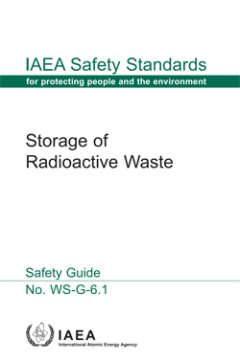
Storage of Radioactive Waste, Safety Guide
Radioactive waste is generated in a broad range of activities involving a wide variety of radioactive materials associated with, for example, the operation of nuclear facilities, the use of sealed radioactive sources in industry, the use of human made radionuclides in hospitals and laboratories, and the decommissioning of such facilities. The physical, chemical and radiological characteristics …
- Edisi
- -
- ISBN/ISSN
- 9201067062 / 1020525X
- Deskripsi Fisik
- 55 p. : Illus. ; 24 cm
- Judul Seri
- Safety Standards Series No. WS-G-6.1
- No. Panggil
- -
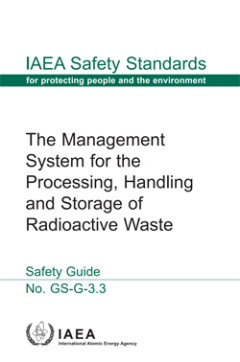
THE MANAGEMENT SYSTEM FOR THE PROCESSING, HANDLING AND STORAGE OF RADIOACTIVE…
The objective of this Safety Guide is to provide guidance on the development and implementation of management systems for the pretreatment, treatment, conditioning and storage of radioactive waste. This publication also includes a description of how to apply the requirements detailed in IAEA Safety Standards Series No. GS-R-3, to the activities associated with producing a packaged waste form fo…
- Edisi
- -
- ISBN/ISSN
- 9789201020086 / 1020525X
- Deskripsi Fisik
- 79 p. : Illus. ; 24 cm
- Judul Seri
- Safety Standards Series No. GS-G-3.3
- No. Panggil
- -
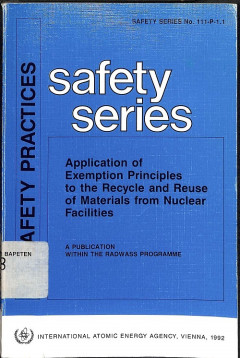
Application of Exemption Principles to the Recycle and Reuse of Materials fro…
This Safety Practices publication, a part of the lAEA’s Radioactive Waste Safety Standards (RADWASS) programme, provides guidance on those application of internationally agreed principles for determining those levels of radionuclides in materials below which they can be exempted from regulatory control and can be recycled or reused without any further restriction. lt illustrates a methodology…
- Edisi
- -
- ISBN/ISSN
- 9201049927 / 00741892
- Deskripsi Fisik
- 204 p. : Illus. ; 24 cm
- Judul Seri
- Safety Series No. 111-P-1.1
- No. Panggil
- 621.48 IAE a
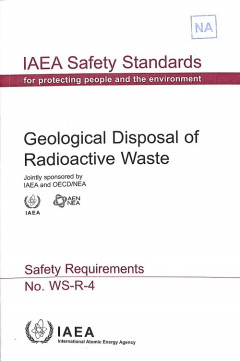
Geological Disposal of Radioactive Waste, Safety Requirements
The objective of this Safety Requirements publication is to set down the protection objectives and criteria for geological disposal and to establish the requirements that must be met to ensure the safety of this disposal option, consistent with the established principles of safety for radioactive waste management.
- Edisi
- -
- ISBN/ISSN
- 920105705
- Deskripsi Fisik
- 49 p. : Illus. ; 24 cm
- Judul Seri
- Safety Standards Series No. WS-R-4
- No. Panggil
- -
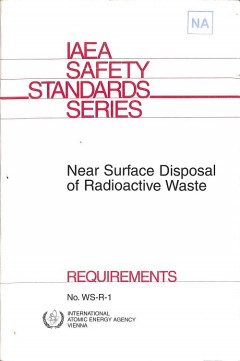
Near Surface Disposal of Radioactive Waste, Requirements
This publication sets out the basic safety requirements related to the disposal of radioactive wastes in near surface repositories. As a Safety Requirements publication it is supported by a number of associated Safety Guides which provide guidance on the implementation of the requirements. Its principles are derived from the Safety Fundamentals publication, Safety Series No. 111-F, The Principl…
- Edisi
- -
- ISBN/ISSN
- 9201010990 / 1020525X
- Deskripsi Fisik
- 29 p. : Illus. 24 cm
- Judul Seri
- Safety Standards Series No. WS-R-1
- No. Panggil
- 621.0397 IAE n
 Karya Umum
Karya Umum  Filsafat
Filsafat  Agama
Agama  Ilmu-ilmu Sosial
Ilmu-ilmu Sosial  Bahasa
Bahasa  Ilmu-ilmu Murni
Ilmu-ilmu Murni  Ilmu-ilmu Terapan
Ilmu-ilmu Terapan  Kesenian, Hiburan, dan Olahraga
Kesenian, Hiburan, dan Olahraga  Kesusastraan
Kesusastraan  Geografi dan Sejarah
Geografi dan Sejarah